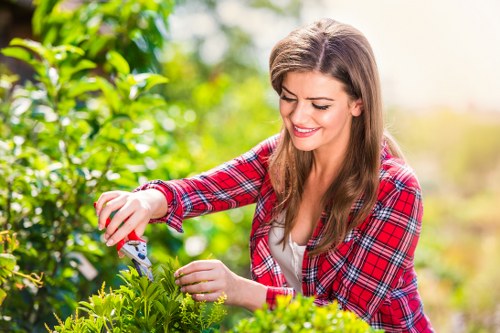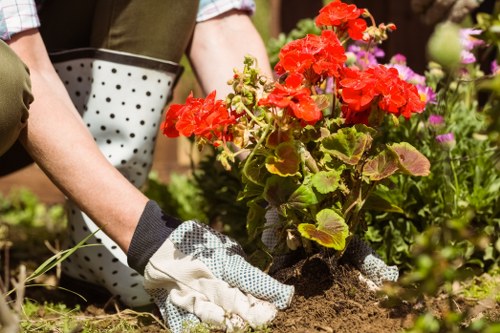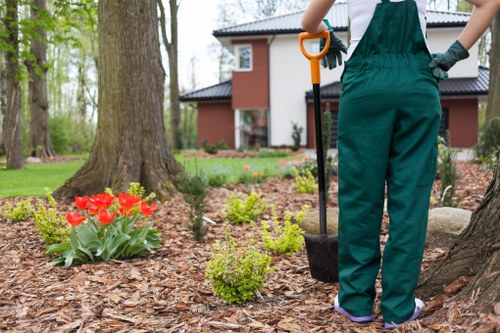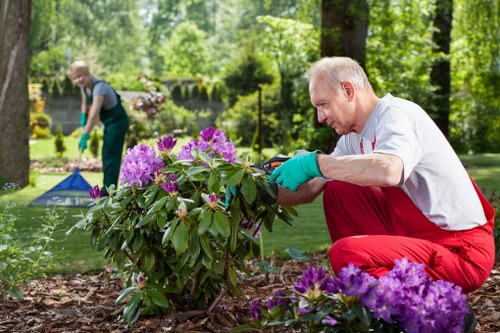Garden Fencing in Garden Services
Introduction to Garden Fencing

Garden fencing is an essential component of garden services, offering both practical and aesthetic benefits. Whether you are looking to define your garden space, enhance privacy, or add a decorative element, selecting the right fence can make a significant difference. In this article, we will explore the various types of garden fencing, their benefits, and how professional garden services can help you achieve the perfect outdoor space.
Understanding the different materials and styles available is crucial in making an informed decision. From traditional wooden fences to modern metal and vinyl options, each type has its unique advantages and considerations. Additionally, proper installation and maintenance play a vital role in ensuring the longevity and effectiveness of your garden fence.
Choosing the right garden fence involves balancing functionality with design preferences. It's not just about enclosing your garden but also about complementing the overall landscape and architecture of your home. Let's delve deeper into the various aspects of garden fencing to help you make the best choice for your outdoor area.
Types of Garden Fencing

There is a wide range of garden fencing options available, each suited to different needs and styles. Here are some of the most popular types:
Wooden Fences
Wooden fences are a classic choice, offering versatility and natural beauty. They can be customized in various heights and styles, from picket fences to solid panels. Wood is a renewable resource, making it an environmentally friendly option when sourced responsibly.
Metal Fences
Metal fences, including wrought iron and aluminum, provide durability and a sleek appearance. They are resistant to weather conditions and require minimal maintenance. Metal fences are ideal for adding a touch of elegance and security to your garden.
Vinyl Fences
Vinyl fences are known for their low maintenance and longevity. They are resistant to rot, insects, and fading, making them a practical choice for various climates. Vinyl fences come in a variety of colors and styles, allowing for customization without the upkeep associated with other materials.
Benefits of Garden Fencing

Installing a garden fence offers numerous benefits that enhance both the functionality and appeal of your outdoor space.
- Privacy: A well-installed fence provides a secluded area, allowing you to enjoy your garden without the prying eyes of neighbors or passersby.
- Security: Fences act as a deterrent to unwanted animals and intruders, ensuring the safety of your plants and property.
- Boundary Definition: Clearly marking the boundaries of your garden helps prevent disputes with neighbors and defines the space for various activities.
- Aesthetic Appeal: A stylish fence can significantly enhance the visual appeal of your garden, complementing its design and adding character to your home.
- Wind and Noise Reduction: Fencing can help buffer against strong winds and reduce noise pollution, creating a more comfortable outdoor environment.
These benefits make garden fencing a valuable investment for homeowners seeking to improve their outdoor living spaces.
Choosing the Right Material

Selecting the appropriate material for your garden fence is crucial in achieving the desired look and functionality. Here are some factors to consider when choosing a material:
Durability
Consider the climate and environmental conditions in your area. Materials like metal and vinyl offer high durability and resistance to weather elements, while wood may require more maintenance to prevent rot and decay.
Maintenance
Different materials require varying levels of upkeep. Vinyl and metal fences generally require less maintenance compared to wooden fences, which may need regular sealing or painting to maintain their appearance.
Cost
Budget is an important factor when selecting a fencing material. While wooden fences may have a lower initial cost, the long-term maintenance expenses can add up. Conversely, vinyl and metal fences might have a higher upfront cost but offer greater longevity and lower maintenance costs.
Assessing these factors will help you choose a material that aligns with your needs, budget, and aesthetic preferences.
Design Considerations

The design of your garden fence should complement the overall style of your home and landscape. Here are some design elements to consider:
Height and Scale
The height of your fence should be appropriate for its intended purpose. For privacy, a taller fence may be necessary, while a shorter fence can serve as a decorative element without obstructing views.
Style and Texture
Choose a style that matches the architectural elements of your home. For example, a traditional picket fence may suit a cottage-style house, while a sleek metal fence could complement a modern home.
Color and Finish
Select colors that blend harmoniously with your garden and home exterior. Natural wood tones, painted finishes, or powder-coated metals can all contribute to the desired aesthetic.
Gates and Accessories
Incorporate gates and accessories that enhance functionality and style. Automated gates, decorative hardware, and integrated lighting can add both convenience and beauty to your garden fence.
Careful consideration of these design aspects ensures that your garden fence not only serves its practical purposes but also enhances the overall look of your outdoor space.
Installation and Maintenance
Proper installation is critical to the effectiveness and longevity of your garden fence. While some homeowners may opt for DIY installation, hiring professional garden services can ensure precision and quality.
Professional Installation Benefits
Professional installers have the expertise and tools necessary to securely erect fences, ensuring they withstand weather conditions and daily wear and tear. They can also provide valuable advice on the best materials and designs for your specific needs.
Maintenance Tips
Regular maintenance extends the life of your garden fence. Here are some tips:
- Inspect Regularly: Check for signs of damage, such as loose boards, rust, or cracks, and address issues promptly.
- Clean Periodically: Remove dirt, debris, and mildew to keep your fence looking its best.
- Protective Coatings: Apply sealants, stains, or paints to wooden fences to prevent moisture damage and maintain their appearance.
- Repair Promptly: Fix any structural issues immediately to avoid more extensive damage.
Consistent maintenance ensures that your garden fence remains functional and visually appealing for years to come.
Sustainability and Eco-Friendly Options
As environmental awareness grows, many homeowners seek eco-friendly fencing options. Sustainable materials and practices not only reduce your environmental footprint but also contribute to a healthier garden ecosystem.
Recycled Materials
Using recycled materials, such as reclaimed wood or recycled metal, minimizes waste and conserves natural resources. These materials often add unique character and charm to your garden fence.
Sustainable Wood Sources
Opt for wood certified by organizations like the Forest Stewardship Council (FSC), which ensures that the wood is sourced responsibly and sustainably. This choice supports responsible forestry practices and helps preserve natural habitats.
Low-Impact Manufacturing
Select materials that are produced with minimal environmental impact. Vinyl and metal fences with eco-friendly manufacturing processes reduce the overall environmental footprint of your fencing project.
- Choose local materials to reduce transportation emissions.
- Opt for durable materials that require fewer replacements.
- Consider modular or reusable fencing systems for greater flexibility.
Incorporating sustainable practices and materials into your garden fencing project benefits both your garden and the planet.
Enhancing Your Garden with Fencing
A well-designed garden fence can transform your outdoor space, providing structure and style. Here are some ways to enhance your garden with fencing:
Creating Defined Areas
Use fencing to delineate different sections of your garden, such as vegetable patches, flower beds, or seating areas. This organization helps in maintaining order and optimizing space usage.
Adding Vertical Interest
Integrate vertical elements like trellises or decorative panels into your fencing design. These additions can support climbing plants and add visual intrigue to your garden.
Incorporating Lighting
Install lighting fixtures along your fence to highlight its design and provide illumination for evening activities. Solar-powered lights are an eco-friendly option that requires minimal maintenance.
Blending with Landscaping
Choose fence styles and colors that harmonize with your landscaping. Integrate plants, vines, or shrubs around the fence to create a seamless transition between the fence and your garden.
By thoughtfully incorporating these elements, your garden fence becomes an integral part of your outdoor design, enhancing both functionality and beauty.
Cost Considerations
Budgeting for your garden fencing project involves considering several factors that influence the overall cost.
Material Costs
The type of material you choose significantly affects the cost. Wooden fences typically have a lower initial cost, while metal and vinyl fences may be more expensive upfront but offer greater durability and lower maintenance costs over time.
Installation Expenses
Professional installation services add to the overall cost but ensure a quality and long-lasting fence. DIY installation can reduce expenses but requires time, effort, and the necessary tools and skills.
Additional Features
Features such as gates, decorative elements, and lighting can increase the cost of your fencing project. It's important to prioritize essential features and consider which additions provide the most value to your garden.
Maintenance Costs
Consider ongoing maintenance expenses when budgeting for your fence. Materials that require regular upkeep, such as wood, may incur higher long-term costs compared to low-maintenance options like vinyl or metal.
- Plan for initial installation and material costs.
- Estimate long-term maintenance and repair expenses.
- Factor in costs for additional features and accessories.
- Compare prices from different suppliers and service providers to find the best value.
By carefully considering these cost factors, you can ensure that your garden fencing project aligns with your budget while meeting your needs and preferences.
Choosing a Professional Garden Service
Partnering with a reputable garden service can significantly enhance the success of your garden fencing project. Here's what to look for:
Experience and Expertise
Choose a garden service with extensive experience in installing and maintaining garden fences. Their expertise ensures that your fence is installed correctly and functions as intended.
Portfolio and References
Review the garden service's portfolio to assess the quality and variety of their work. Request references or read reviews to gauge customer satisfaction and reliability.
Customization Options
A good garden service offers customization to meet your specific needs and preferences. Whether you desire a particular style, material, or feature, they should be able to accommodate your requests.
Competitive Pricing
Obtain quotes from multiple garden services to compare pricing. Ensure that the quotes include all aspects of the project, such as materials, labor, and any additional features.
- Verify licenses and insurance to protect against potential liabilities.
- Assess the garden service's communication and responsiveness.
- Ensure they provide a clear contract outlining the project scope and terms.
Selecting the right professional garden service guarantees a smooth and successful fencing project, tailored to your unique garden needs.
Maintenance and Longevity
Ensuring the longevity of your garden fence requires regular maintenance and timely repairs. Here are some tips to keep your fence in optimal condition:
Regular Inspections
Conduct regular inspections to identify any signs of wear and tear, such as rust on metal fences, cracks in vinyl, or rot in wooden fences. Early detection allows for prompt repairs, preventing minor issues from escalating.
Cleaning
Keep your fence clean by washing it periodically. Use appropriate cleaning solutions based on the material—mild soap and water for wood and vinyl, anti-rust treatments for metal fences.
Protective Treatments
Apply protective treatments to extend the life of your fence. Wooden fences benefit from sealing or staining, while metal fences may require repainting or applying rust inhibitors.
Fastening and Structural Integrity
Check and secure any loose fasteners or panels. Ensure that the fence remains structurally sound to maintain its appearance and functionality.
- Address damage immediately to avoid further deterioration.
- Consider seasonal maintenance tasks, such as winterizing wooden fences.
- Replace damaged sections as needed to maintain a cohesive look.
Consistent maintenance practices enhance the durability and appearance of your garden fence, ensuring it remains a valuable asset to your garden services.
Innovative Fencing Solutions
Advancements in fencing technology offer innovative solutions that enhance functionality and aesthetics. Here are some modern trends in garden fencing:
Smart Fencing
Integrate technology into your fence with smart features such as automated gates, motion sensors, and integrated lighting. These features add convenience and security, making your fence more interactive and efficient.
Decorative Panels
Use decorative panels with intricate designs or patterns to add visual interest. These panels can serve as art pieces, enhancing the aesthetic appeal of your garden while maintaining the fence's practical functions.
Modular Fencing Systems
Modular fencing systems offer flexibility and ease of installation. These systems allow you to customize the height, style, and layout of your fence, adapting to changing garden needs.
Eco-Friendly Innovations
Explore eco-friendly fencing options, such as living fences made from interwoven plants and shrubs. These natural barriers provide privacy and improve air quality, contributing to a healthier garden environment.
- Incorporate renewable energy sources for powering smart features.
- Use recyclable materials to create sustainable fencing solutions.
- Design multifunctional fences that support plants and wildlife.
Embracing these innovative fencing solutions can elevate your garden's functionality and aesthetic, keeping it up-to-date with modern trends in garden services.
Conclusion
Garden fencing is a vital element of garden services, offering a blend of practicality and beauty. By carefully selecting the right materials, design, and professional services, you can create a fence that not only meets your functional needs but also enhances the overall appeal of your outdoor space.
Investing in a quality garden fence provides long-term benefits, including increased privacy, security, and aesthetic value. Regular maintenance ensures that your fence remains in excellent condition, offering enduring value for your investment.
Ready to transform your garden with the perfect fence? Contact us today to explore your options and book your service now. Let our experts help you create the garden space of your dreams with professional fencing solutions tailored to your needs.